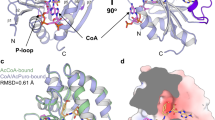Summary
The utilisation of acetylhistidine by histidine auxotrophs of E. coli K-12 was found to require a functioning acetylornithinase. The growth, on acetylhistidine-containing media, of his mutants possessing this enzyme was inhibited by arginine or its precursors acetylornithine, ornithine and citrulline. Mutants able to overcome this inhibition belonged to two classes: those (selected on acetylhistidine+acetylornithine or arginine) in which the arginine biosynthetic enzymes were repressible, as in the parent strains; and those (selected on acetylhistidine+acetylornithine, ornithine, citrulline or arginine) in which these enzymes were formed at high, non-repressible levels. The altered properties of the first class were shown genetically not to result from mutation in the argR or argECBH regions; the data are consistent with the second class carrying mutations at the argR locus.
It is supposed that arginine, ornithine or citrulline, by repressing the formation of acetylornithinase, diminish the rate at which acetylhistidine can be utilised (although an acetylhistidine uptake system under arginine control would equally explain the results); non-repressible mutants would escape this effect. The kinetic properties, in crude extracts, of acetylornithinase from the parent strains and from members of each mutant class, with acetylornithine and acetylhistidine as substrates, were investigated. It was tentatively concluded that, in accord with the genetic results, the first class do not possess an acetylornithinase altered to make it function better with acetylhistidine as substrate. It is suggested that arginine may affect acetylhistidine utilisation by affecting its uptake in a manner not shared with ornithine or citrulline, as well as by repressing proteins of the arginine system, and that this arginine-specific effect is inoperative in the first class of mutants. The nature of the changes leading to ability to grow on acetylhistidine+acetylornithine remains unknown. Possible applications of these findings to the selection of hitherto undiscovered but potentially informative mutant types are discussed.
Similar content being viewed by others
References
Adams, J. M.: On the release of the formyl group from nascent protein. J. molec. Biol. 33, 571–589 (1968).
Albrecht, A. M., Vogel, H. J.: Acetylornithine δ-transaminase: partial purification and repression behaviour. J. biol. Chem. 239, 1872–1876 (1964).
Bacon, D. F., Vogel, H. J.: “Internal cross-feeding” and repressive control. Fed. Proc. 22, 476 (1963).
Baumberg, S., Bacon, D. F., Vogel, H. J.: Individually repressible enzymes specified by clustered genes of arginine synthesis. Proc. nat. Acad. Sci. (Wash.) 53, 1029–1032 (1965).
Bollon, A. P., Leisinger, T., Vogel, H. J.: Differential repressor effectiveness in Escherichia coli under adjustable arginine restriction in batch cultures. Genetics 61, s6 (1969).
Davis, B. D., Mingioli, E. S.: Mutants of Escherichia coli requiring methionine or vitamin B12. J. Bact. 60, 17–28, (1950).
Elseviers, D., Cunin, R., Glansdorff, N.: Reactivation of arginine genes under the influence of polar mutations. FEBS Letters 3, 18–20 (1969).
Fry, K. T., Lamborg, M. R.: Amidohydrolase activity of Escherichia coli extracts with formylated amino acids and dipeptides as substrates. J. molec. Biol. 28, 423–433 (1967).
Glansdorff, N.: Topography of cotransducible arginine mutations in Escherichia coli K-12. Genetics 5, 167–179 (1965).
— Sand, G.: Coordination of enzyme synthesis in the arginine pathway of Escherichia coli K-12. Biochim. biophys. Acta (Amst.) 108, 308–311 (1965).
Itikawa, H., Baumberg, S., Vogel, H. J.: Enzymic basis for a genetic suppression: accumulation and deacylation of N-acetylglutamic γ-semialdehyde in enterobacterial mutants. Biochim. biophys. Acta (Amst.) 159, 547–550 (1968).
Lennox, E. S.: Transduction of linked genetic characters of the host by bacteriophage Pl. Virology 1, 190–206 (1955).
Maas, W. K.: Studies on repression of arginine biosynthesis in Escherichia coli. Cold Spr. Harb. Symp. quant. Biol. 26, 183–191 (1961).
Pittard, J., Loutit, J. S., Adelberg, E. S.: Gene transfer by F' strains of Escherichia coli K-12. I. Delay in initiation of chromosome transfer. J. Bact. 85, 1394–1401 (1963).
Reiner, A. M.: Isolation and mapping of polynucleotide phosphorylase mutants of Escherichia coli. J. Bact. 97, 1431–1436 (1969).
Satake, K., Okuyama, T., Ohashi, M., Shinoda, T.: The spectrophotometric determination of amine, amino acid and peptide with 2,4,6-trinitrobenzene 1-sulfonic acid. J. Biochem. (Tokyo) 47, 654–660 (1960).
Siegel, E. C., Bryson, V.: Mutator gene of Escherichia coli B. J. Bact. 94, 38–47 (1967).
Taylor, A. L., Trotter, C. D.: Revised linkage map of Escherichia coli. Bact. Rev. 31, 332–353 (1967).
Thompson, J. F., Gering, R. K.: Preparation of N α-acetylornithine. Arch. Biochem. 99, 326–327 (1962).
Urm, E., Leisinger, T., Vogel, R. H., Vogel, H. J.: Gene governing magnesium sensitivity in Escherichia coli K-12. Genetics 61, s59 (1969).
Vogel, H. J.: Repression of an acetylornithine permeation system. Proc. nat. Acad. Sci. (Wash.) 46, 488–494 (1960).
— Bonner, D. M.: Acetylornithinase of Escherichia coli: partial purification and some properties. J. biol. Chem. 218, 97–106 (1956).
Weissbach, H., Redfield, B.: Deformylation of N-formylmethionine by Escherichia coli extracts. Biochem. biophys. Res. Commun. 27, 7–11 (1967).
Author information
Authors and Affiliations
Additional information
Communicated by W. K. Maas
Rights and permissions
About this article
Cite this article
Baumberg, S. Acetylhistidine as substrate for acetylornithinase: A new system for the selection of arginine regulation mutants in Escherichia coli . Molec. Gen. Genet. 106, 162–173 (1970). https://doi.org/10.1007/BF00323835
Received:
Issue Date:
DOI: https://doi.org/10.1007/BF00323835




